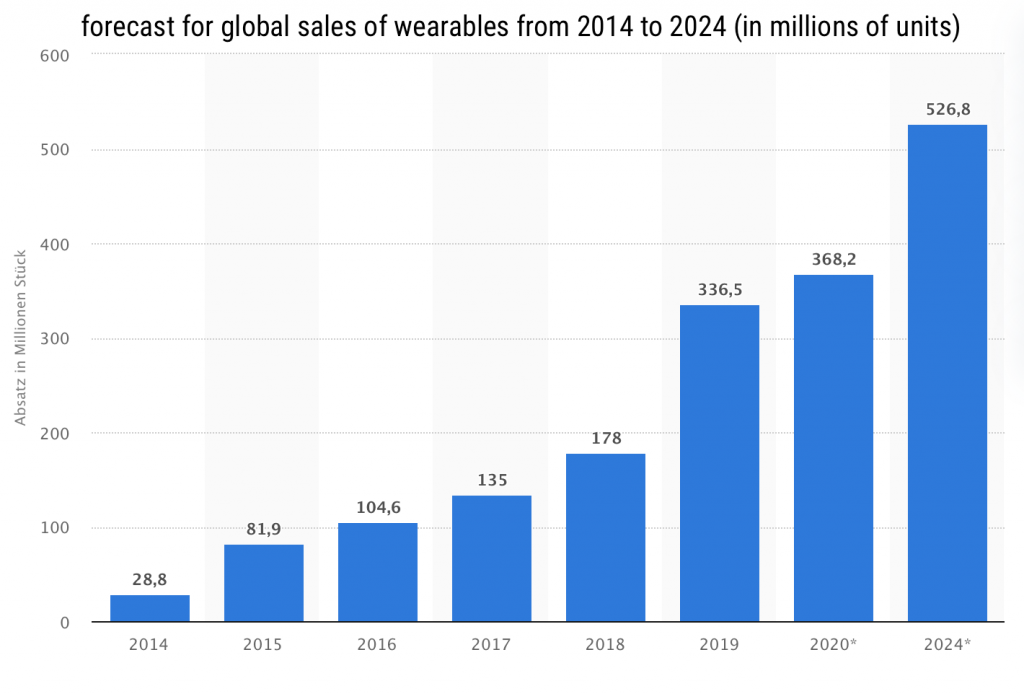Rise of the wearables
Wearables are taking over the world by storm. The market for these small, smart companions has grown more than tenfold over the last five years. Development is proceeding at breakneck speed: wearables as potential Covid-19 detectors, smart data glasses or integrated clothing microchips are just some of many new trends.
Wearables are still a relatively young phenomenon. In 1997, computer science professor Steven Mann, who is generally regarded as the intellectual father of the small devices, first described in an article his vision of computer systems becoming a form of “second brains” for clothing and the body.
In economic terms, smartwatches, fitness trackers and earwear in particular did not become truly relevant until 2014, when 28.8 million units were sold around the world. Five years later, in 2019, the figure increased to more than 10 times this amount to 336.5 million. And by 2024, this figure is expected to rise – at a very conservative estimate – to over 500 million wearables sold worldwide.

Rise of the wearables
Smart companions have long since become mainstream. 71 percent of Germans, for example, own at least one pair of earbuds for listening to music, an increasing number of which work entirely without cables via Bluetooth. Smartwatches and fitness trackers are also in vogue and are becoming more and more widespread.
In a recent comparison survey of smartwatches and fitness trackers, a leading German safety group called “Stiftung Warentest” found that only three of the 21 devices tested, are measuring the heart rate, distance traveled, and calories burned correctly. Only those three devices were therefore awarded a good test grade. This shows that there is still a lot of room for improvement.
On the other hand, reputable scientists already consider data collected via microsensors to be accurate enough to help us combat the coronavirus pandemic.
Covid-19: Wearables can predict the virus with an accuracy of 90 percent
In addition measuring a person’s resting heart rate, many fitness wristbands and smartwatches can also measure your recovery heart rate and blood oxygen saturation. They can also evaluate your sleep and activity information. Your health data can change drastically if you are infected with an acute respiratory disease such as Covid-19.
Researchers from the Robert Koch Institute (RKI), Germany’s national public health organisation, are already working on different models of how this vital data can be used for the early detection of Covid-19 infection. The RKI have already developed a coronavirus-waring app and they are working closely with the German Center for Cardiovascular Research and Stanford University
The Rockefeller Neuroscience Institute at West Virginia University claims to have achieved remarkable success by matching data collected from wearables with their AI models: According to them, a corona infection can be detected with 90 percent certainty three days before the infected person even notices the first symptoms.
Adapting and rolling out this kind of knowledge and technology integration on a global scale could decisively slow down the spread of a dangerous virus like Covid-19 in the near future.
Wearables are gaining traction in the healthcare industry
Proving to be a reliable sidekick in the battle against Covid-19 would confirm the importance and significant impact that wearables can and will have on the healthcare industry moving forward.
Covid-19 detection is just one of many new uses of wearables in healthcare. The Fraunhofer Institute for Integrated Systems and Device Technology (IISB), for instance, is working on a small sensor called “Elecsa” that constantly collects body data through sweat. This allows them to monitor someone’s training and health data accurately without that person having to wear a chest strap or any other inhibiting, external body wear. IISB’s initial research suggests that there will be quite a few meaningful ways of making use of this new technology in the medical and health industries, as well as in the sports sector.
The latest trends: from smart insoles to vibrating panties
The integration of wearable sensors into clothing is called smart-electro clothing systems (SeCSs) and they are a form of printed electronics.
Below are a few types of SeCSs that are already in use:
- Professional sports clubs and TV broadcasters use data transmitted from smart insoles in athletes’ and players’ shoes, which can measure stats like distance covered, maximum and average speed, passes attempted, shot power, and more.
- The sole of Under Armour’s new “Hovr” running shoe has an integrated chip that provides direct feedback on the runner’s cadence via the “Map my Run” app. This means that runners can make changes in real-time while they are running.
- Smart ski boots with sensors, like Atomic’s “Hawx Ultra Connected”, help skiers to refine their skills by becoming aware of where they have room to adjust their technique with greater balance or pressure. The embedded force sensors in the ski boots deliver accurate feedback for a safer and more enjoyable skiing experience.
- Vibrating remote-controlled panties have become more and more sophisticated over the last few years as well. “Fundawear” from Durex for example is a wearable technology which allows personal touch to be transferred from a smartphone app to either yourself or a partner anywhere in the world. It comes in both male and female versions and takes touch input from one partner via their app and sends these signals in real-time to their partner’s app. From here it is transferred to the Fundawear garment where the touch sensation is recreated on the skin. As this all happens in a split second the experience apparently feels very natural.
From solar bikinis to live data transmission for individual sports
Apart from the smart-electro clothing systems outlined above, smart sensors and microchips are now being used in various other creative ways as well. Innovative concepts such as generating your own energy via solar cells in your clothes or backpacks, and virtual reality swimming and skiing goggles are becoming reality.
High-efficiency stretchable solar cells can now be incorporated into flexible robot skin or stretchy wearable electronics. These wearable photovoltaic platforms are easily adaptable and by harvesting energy from sunlight can supply various electronic devices with energy.
There already exists a prototype of a solar bikini made of flexible solar panel cells that can charge while the wearer is sunbathing. The bikini is made up of 40 individual flexible photovoltaic cells in the shape of a bikini top and bottom. It features a USB socket that when tested was enough to power a handphone or a tablet.
Individual sports such as skiing and swimming have recently seen the adaptation of smart wearable technology as well. Smart ski goggles showing skiers live info, including their current speed detected by sensors, or a guide to the ski lift with the fewest people currently waiting in line will soon become reality.
The potential applications of wearables are almost limitless – eleven percent of smartwatch owners already use their wearable to control smart applications in their own home, for example.
Wearables are the new MVPs
The coronavirus pandemic has further accelerated the digital transformation and digitisation. Even before Covid-19 struck, sales in the wearables market were forecasted to rise from $52 billion this year to $63 billion in 2021. Significant changes have taken place among the major players in recent years.
Fitbit was the dominant market leader at the start of the wearable boom in 2014, with a 37.9 percent market share. While they were losing significant market share since then, the very recent EU approval of Google’s takeover of the company should see a significant comeback from Fitbit in the next few years. In order for the EU to grant their approval, Google had to pledge not to hinder their rivals and also most crucially not to use Fitbit’s health data for its own advertising purposes.
Currently Apple is the clear leader in terms of market share and they are continuously strengthening their number one position. Samsung and Huawei have also been able to significantly increase their respective market shares in recent years.
Below is an overview of the wearable market in 2019:
1. Apple (market share: 31.7 percent)
2. Xiaomi (12.4 percent)
3. Samsung (9.2 percent)
4. Huawei (8.3 percent)

Sources:
https://www.idc.com/getdoc.jsp?containerId=prUS46432620
https://www.idc.com/tracker/showproductinfo.jsp?prod_id=962
https://de.statista.com/statistik/daten/studie/515709/umfrage/marktanteile-der-hersteller-am-absatz-von-wearables-weltweit/
https://www.bitkom.org/en
https://www.iis.fraunhofer.de/en/ff/sse/health/medical-sensors-and-analytics/prod/elecsa.html
https://www.mdpi.com/1424-8220/20/3/587/htm
https://www.trendhunter.com/trends/ski-boot
https://techcrunch.com/2013/04/18/durexs-new-long-distance-sexy-time-fundawear-is-exactly-that/
https://www.intelligentliving.co/high-efficiency-stretchable-solar-cells-for-wearables-and-robots/
https://crunchwear.com/solar-bikini-makes-going-green-look-hot/
https://www.bbc.com/news/technology-55350796
